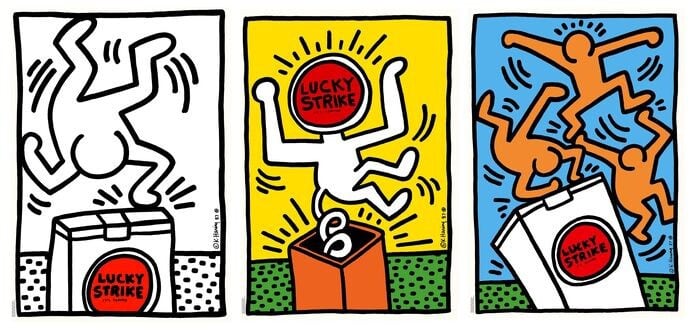
In the mid-1980s, Keith Haring entered a unique space where commercial branding and fine art converged as one. His 1987 Lucky Strike series showcases not only his use of bold lines and energetic figures, but also his keen awareness of consumer culture at a time where the line between art and advertising was beginning to blur.
Commissioned by Lucky Strike Switzerland and arranged by art consultant Pierre Keller, the series includes prints that combine the instantly recognizable cigarette brand’s logo with Haring’s iconic dancing figures. Rather than a typical advertising campaign, Haring’s work uses brand imagery in a way that is both playful and critical, highlighting how consumer products flood visual culture.
This collaboration was an early example of what has now become a widespread trend: partnerships between artists and brands. Today, such collaborations define much of contemporary culture, with luxury labels working with street artists, sneaker companies commissioning painters, and logos becoming part of the artistic language. But in 1987, these kinds of partnerships were less common and carried more complex cultural meaning.
Inspired by Andy Warhol’s approach of turning commercial icons into fine art, Haring embraced the Lucky Strike commission with enthusiasm and his usual activist spirit. He created ten ink drawings, nine lively, playful blends of the Lucky Strike box and his animated figures. The tenth, a stark skeleton smoking a cigarette, was rejected by the client, but shows Haring’s ongoing commitment to social commentary, even within commercial limits.
What makes the Lucky Strike series so compelling is how it reveals the tension between commodification and artistic expression. The cigarette brand, a symbol of consumer desire and corporate influence, is transformed through Haring’s vision into a symbol that encourages reflection. His dancing figures, full of energy and movement, become icons of urban life, joy, and the contradictions within consumer culture.
This project also marks a key moment in the evolving relationship between art and branding. Long before brand collaborations exploded in the 21st century, Haring’s Lucky Strike series hinted at a cultural shift where art and commerce intertwine and influence each other.
Today, as brand collaborations dominate art fairs, galleries, and popular culture, revisiting Keith Haring’s Lucky Strike series reminds us that these intersections are not new. They are rooted in the work of artists like Haring, who saw both the creative possibilities and critical power in blending commercial imagery with artistic vision.